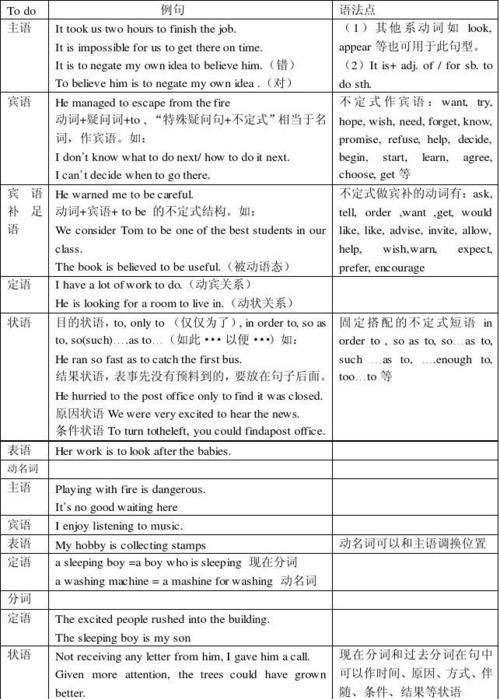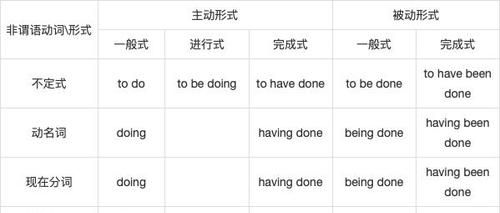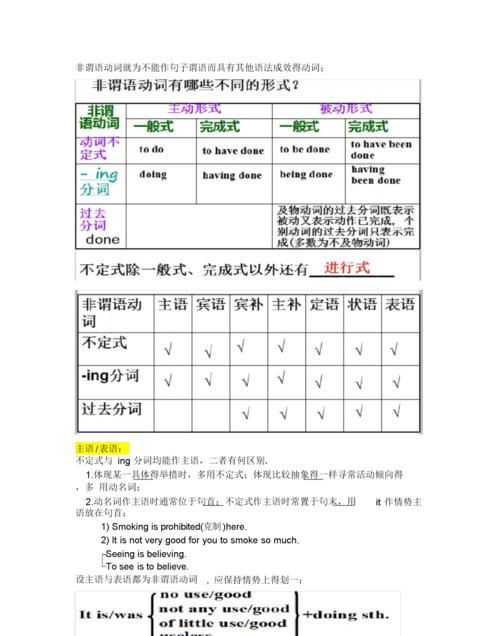本文目录
非谓语动词的用法
导语: 非谓语动词在英语中很常见,关于非谓语动词的语法知识自然就要大家能够熟练掌握。下面是我为您收集整理的非谓语动词的用法,欢迎阅读!
一、非谓语动词的概念
动词的基本用法是作谓语。当句中已经有了谓语动词了,要选或要填的动词就只能用非谓语形式了。
非谓语形式有三种:1、动词不定式:to do 2、动词的ing : doing 3、动词的过去分词:done。其中不定式表示目的和将来;动词的ing表示主动和进行;过去分词表示被动和完成。
二、非谓语动词的时态和语态
一般式:不定式:主动to do ,被动to be done ; ing 形式:主动doing ,被动being done ;过去分词:被动done
完成式:不定式:主动to have done ,被动to have been done;ing 形式:主动having done,被动having been done
进行式: 不定式to be doing
三、非谓语动词的复合结构
不定式的复合结构:for / of sb. to do sth.
动词 ing 形式的复合结构:宾格或所有格+doing (-ing 形式作主语时,用的所有格+doing)
1. 不定式和动名词作主语的区别
(1)动名词作主语时,通常用以表示一件已知的事或经验,不定式短语通常用来表示一件未完成的事或目的。
Driving a car during the rush hour is tiring.在高峰时刻开车令人厌烦。(经验)
(2)不定式做主语,一般用it当形式主语,把作主语的不定式短语后置。
It took me only five minutes to finish the job.
2. 不定式、动名词和分词作表语的区别
(1)不定式作表语
① 不定式作表语一般表示具体动作,特别是表示将来的动作。
What I would suggest is to start work at once.我的建议是立刻开始干。
② 如果主语是不定式(表示条件),表语也要是不定式(表示结果)。
To see is to believe.百闻不如一见。
(2)动名词作表语:动名词作表语,表示抽象的一般性的`行为。
His hobby is collecting stamps.他的爱好是集邮。
(3)分词作表语
分词做表语有两种情况,一种是现在分词做表语,一种是过去分词做表语,这两者区别是考试中经常考到的地方。
puzzling令人费解的--puzzled感到费解的
satisfying令人满意的---satisfied感到满意的
The pupils will get confused if they are made to learn too much.如果要学生学得太多,他们会感到糊涂的。
The argument is very convincing.他的论点很令人信服。
3. 不定式和动名词作宾语的区别
(1)有少数动词只能用动名词作宾语
acknowledge,admit ,dislike, advocate,complete,appreciate ,avoid,enjoy,delay,escape,deny
例如:I appreciate having been given the opportunity to study abroad two years ago.
我很感激两年前给我出国学习的机会。
(2)有些动词后使用动名词和动词不定式作宾语的差别
① forget to do 忘记要去做某事(此事未做),forget doing忘记做过某事(此事已做过或已发生)
② stop to do 停止、中断(某件事),目的是去做另一件事。stop doing 停止正在或经常做的事
③ remember to do 记住去做某事(未做),remember doing记得做过某事(已做)
④ regret to do对要做的事遗憾,regret doing对做过的事遗憾、后悔
⑤ try to do努力、企图做某事,try doing试验、试一试某种办法
⑥ mean to do打算,有意要…,mean doing意味着
4. 不定式和分词作状语的区别
(1)现在分词与过去分词作状语的区别。
① 现在分词作状语时,现在分词的动作就是句子主语的动作,它们之间的关系是主动关系。
Not knowing what to do, he went to his parents for help.
② 过去分词作状语时,过去分词表示的动作是句子主语承受的动作,它们之间的关系是被动关系。
Given more attention, the trees could have grown better.
5. 非谓语动词常考的其它结构
(1)疑问词+不定式结构
疑问词who,what,which,when,where和how后加不定式可构成一种特殊的不定式短语。它在句中可以用作主语、宾语、表语和双重宾语。
When to start has not been decided.何时动身尚未决定。(主语)
I don't know what to do.我不知道该怎么办。(宾语)
The difficulty was how to cross the river.困难在于如何过河。(表语)
I can tell you where to get this book.我可以告诉你哪里可以买到此书。(双重宾语)
(2)不带to的不定式
① 在表示生理感觉的动词后的不定式不带to。
这类词有: feel observe overhear watch listen to perceive notice see look at hear
On seeing the young child fell into the lake,Eric sprang to his feet,and went on the rescue.
② 另一类是某些使役动词,如make, let,have等。
I would have you know that I am ill.我想让你知道我病了。
上述感觉动词与使意动词转换为被动结构时.其后的不定式一般需带to,
The boy was made to go to bed early.
③ 在do nothing/anything/everything but(except)结构中。
例如:Last night I did nothing but watch TV.
但是,如果谓语动词不是“do nothing,anything,everything”,那么but(except)所跟的不定式则仍须带to。
There was nothing for them to do but to remain silent.

非谓语动词的用法总结
非谓语动词的用法总结:1.不定式(todo):做主语、宾语、表语、定语、状语和补语。2.动名词(doing):做主语、宾语、表语、定语。
非谓语动词的用法总结
非谓语动词有四种形式:不定式,动名词,分词:现在分词,过去分词。
1.不定式(todo):做主语、宾语、表语、定语、状语和补语。
2.动名词(doing):做主语、宾语、表语、定语。
3.现在分词(doing):做表语、定语、状语和补语。
4.过去分词(done):做表语、定语、状语和补语。
非谓语动词
非谓语动词,又叫非限定动词,非谓语动词是指在句子中不是谓语的动词,主要包括不定式、动名词和分词(现在分词和过去分词),即动词的非谓语形式。非谓语动词除了不能独立作谓语外,可以承担句子的其他成分。

非谓语动词语法讲解ppt
非谓语动词用法详解
动词的非谓语形式有三种:不定式、动名词和分词
(一)不定式
不定式由“ to十动词原形”构成,其否定形式是“ not to do”.不定式可以带宾语或状语构成不定式短语,没有人称和数的变化,但有时态和语态的变化.不定式可作主语、宾语、状语、表语和定语,但不能单独作谓语.不定式的逻辑主语有时用“ for十名词或代词宾格”构成.
1.不定式的用法:
l)作主语.不定式短语作主语时,往往放在谓语之后,用 it作形式主语.例如:
To see is to believe.
It is right to give up *** oking.
2)作宾语.不定式短语作宾语时,如果还带有宾语补足语.往往把不定式宾语放在宾语补足语之后,而用 it作形式宾语.例如:
He wanted to go.
I find it interesting to study work with him.
3)作宾语补足语.例如:
He asked me to do the work with him.
注意 :在 feel,hear,listen to,look at,notice, observe,see,watch,have, let,make等词后的补足语中,不定式不带 to.但是这些句子如果变成被动结构时,就必须带 to.例如
I often hear him sing the song.
He is often heard to sing the song.
注意:不定式动词在介词 but,except,besides后面时,如果这些介词之前有行为动词 do的各种形式,那么,这些介词后的不定式不带 to,否则要带 to.如:
She could do nothing but cry.
What do you like to do besides swim?
I have no choice but to go.
4)作定语.例如:
I have some books for you to read.
注①作定语的不定式如果是不及物动词,或者不定式所修饰的名词或代词是不定式动作的地点、工具等,不定式后面须有相应的介词.例如:
He is looking for a room to live in.
There is nothing to worry about.
Please give me a knife to cut with.
但是,不定式所修饰的名词如果是 time,place或 way,不定式后面的介词习惯上要省去.例如:
He had no money and no place to live.
注②当作定语的不定式所修饰的名词或代词是不定式动作的承受者时,不定式既可以用主动语态,也可用被动语态,但其含义有所不同.试比较:
A) Have you anything to send? 你有什么东西要寄吗?
(不定式 to send的动作执行者是 you)
B) Have you anything to be sent? 你有什么要(我或别人)寄的东西吗?
(不定式 to be sent的动作执行者是已被省略的 me或someone else)
5)作状语,表示目的、原因、结果或条件.例如:
I came here to see you.(目的)
We were very excited to hear the news.(原因)
He hurried to the school to find nobody there.(结果)
To look at him, you would like him.(条件)
目的状语还可以用 in order to或 so as to来表示.如:
In order to pass the exam, he worked very hard.
We ran all the way so as not to be late.
不定式也可在作表语用的形容词后面作状语.例如:
I am very glad to hear it.
The question is difficult to answer.
“ too十形容词或副词十不定式”作状语.例如:
He is too old to do that.
另外句子中有 enough这个词时,常用不定式作状语.例如:
The room is big enough to hold us.
6)作表语.例如:
My job is to help the patient.
7)作独立成分.例如:
To tell the truth, I don’t agree with you.
8)不定式与疑问词 who,which,when,where,how,what等连用,在句中起名词作用,可充当主语、表语、宾语等.例如:
He didn’t know what to say.(宾语)
How to solve the problem is very important.(主语)
My question is when to start. (表语)
注意:在与 why连用时,只用于 why或 why not开头的简短疑问句中,后面紧跟的动词不定式不带 to. 例如:
Why not have a rest?
9)不定式在句中用主动式还是被动式.多数情况下是容易判别的,但有时的确比较复杂,请注意以下几点:
A)不定式修饰的名词或代词和不定式构成逻辑上的主谓关系时,不定式往往用主动形式.
Have you got a key to unlock the door?
(A key unlocks the door.)
B)不定式和它前面被修饰的名词或代词构成逻辑上的动宾关系,又和该句主语构成逻辑上的主谓关系时,不定式常用主动形式.
I have got a letter to write.( I write letter.)
He needs a room to live in.( He lives in a room.)
I know what to do.( I do what.) 但这句如改为下列形式,不定式就得用被动形式:
I know what is to be done.
这是因为 what is to be done是宾语从句,从句中的主语 what是动词 do的动作对象
C)不定式作表语形容词的状语,和句中主语构成逻辑上的动宾关系时,不定式多用主动形式,这是因为人们往往认为形容词后省去了 for one或 for people.例如:
He is hard to talk to.( to talk to him.)
The book is difficult to understand. ( to understand the book.)
但如果强调句中的受事者时,亦可用不定式被动式,例如:
The handwriting is very difficult to be read.
The box is too heavy to be lifted.
D)在 “there十be” 的结构中,当说话人考虑的是必须有人去完成某件事时,不定式用主动形式,如果说话人强调的是事情本身必须完成,则用被动形式.
There is a lot of work to do. ( Somebody has to do the work.)
There is a lot of work to be done. ( The work has to be done.)
请注意下面两个句子的含义是不同的:
There is nothing to do. 意为无事可做,感到十分乏味.
There is nothing to be done.意为某东西坏了,无法使之恢复正常.
2.不定式的时态
l)不定式的一般形式所表示的动作,通常与谓语的动作(状态)同时(或几乎同时)发生,或是在它之后发生.例如:
I saw him go out.
2)如果谓语表示的动作(情况)发生时,不定式表示的动作正在进行,这时不定式就要用进行式.例如:
I am very glad to be working with you.
3)如果不定式的动作发生在谓语动词之前,就要用完成式.例如:
I’m sorry to have kept you waiting.
3.不定式的语态
当不定式逻辑上的主语是这个不定式所表示的动作的承受者时,不定式一般要用被动形式.例如:
He asked to be sent to work in the countryside.
It is possible for our hopes to be realized.
(二)动名词
1.动名词由动词 + ing构成;具有动词和名词的性质;在句中起名词作用,可作主语、宾语、表语和定语.
1)作主语.例如:
Seeing is believing.
Laying eggs is the ant queen’s full- time job.
It is no use arguing with him.
注意:动名词和不定式都可以作主语,动名词作主语表示一般或抽象的多次性行为,不定式作主语往往表示具体的或一次性的动作.例如:
Playing with fire is dangerous.(泛指玩火)
To play with fire will be dangerous.(指一具体动作)
但在 It is no use/ good,not any use/ good,useless等后必需用动名词.
2)作表语.例如:
Her job is teaching.
3)作宾语.例如:
He is fond of playing football.
I like swimming.
注① admit,appreciate,avoid,consider, delay, dislike,enjoy,escape, excuse,face,feel. like,finish,forgive,give up, imagine,include,keep,mention,mind,miss,practise,put off,resist, risk,suggest,can’t help,can’t stand(无法忍受)等动词后可以用动名词作宾语,但不能用不定式.
注② forget,go on,like,mean,regret,remember,stop,try等动词可带动名词或不定式作宾语,但意义上有区别.
I remember doing the exercise. (我记得做过练习.)
I must remember to do it. (我必须记着做这事.)
I tried not to go there.(我没法不去那里.)
I tried doing it again. (我试着又干了一次.)
Stop speaking. (不要讲话.)
He stopped to talk. (他停下来讲话.)
I mean to e early today. (我打算今早些来.)
Missing the train means waiting for another hour.(误了这趟火车意味着再等一个小时.)
注③在 allow,advise,forbid,permit等动词后直接跟动词作宾语时,要用动名词形式,如果后面有名词或代词作宾语,然后再跟动词作宾语补足语时,其宾语补足语用带 to的不定式.例如:
We don’t allow *** oking here.
We don' t allow students to *** oke.
注④动词 need,require,want作“需要”解,其后跟动词作它的宾语时,必须用动名词,或不定式的被动式.这时,动名词的主动式表示被动意义.例如:
The window needs( requires,wants) cleaning( to be cleaned)
注⑤在短语 devote to,look forward to,stick to,to be used to,object to,thank you for,excuse me for,be( kept) busy,be worth,have difficulty/ trouble/ problem (in),have a good/ wonderful/ hard time(in),there’s no use/good/ need,feel/ look/seem/ like/get down to等后的动词也必须用动名词形式.例如:
I look forward to hearing from you soon.
注⑥在 love,hate,prefer等动词后用动名词或不定式无多大区别.但说话人有所指的时候,通常用不定式.
注⑦start,begin,continue在书面语中多后接动名词,在口语中多后接不定式.
注⑧在 should(would) like/ love等后须用不定式.
4)作定语.例如:
He has a reading room.
2.动名词的复合结构
动名词的复合结构由形容词性的物主代词或人称代词的宾格,名词所有格或普通格加动名词构成.在句子开头必须用名词所有格或形容词性的物主代词.例如:
His ing made me very happy.
Mary’s crying annoyed him.
She didn’t mind his crying.
Is there any hope of Xiao Wang’s winning.
3.动名词的时态和语态.
l)动名词的时态
动名词的时态分一般式和完成式两种,如果动名词的动作没有明确地表示出时间是与谓语动词同时发生或在谓语动作以前发生,用动名词的一般式.例如:
We are interested in playing chess.
His ing will be of great help to us.
如果动名词的动作发生在谓语动词所表示的动作之前,通常用动名词的完成时态.例如:
I’m sorry for not having kept my promise.
但是在某些动词或词组后,常用动名词的一般形式,尽管其动作是在谓语所表示的动作之前发生的.例如:主语是这个动名词表示的动作的对象时,动名词用被动语态.被动语态由“ being十过去分词”或“ having been十过去分词”构成.后一种一般避免使用.例如:
He likes being helped.
He was afraid of being left at home.
注:在 to be worth doing句型中,动名词 doing表示的是被动意义.例如:
The book is worth reading.
(三)分词
1.分词的时态和语态
l)分词分为现在分词和过去分词.现在分词有一般式和完成式.一般式表示和谓语动词所表示的动作同时发生的行为;完成式(having十过去分词)表示在谓语动词所表示的动作之前发生的动作.例如:
Being a student,he was interested in books.
Having studied in the university for 3 years, he knows the way very well.
2)现在分词有一般式和完成式,且有主动语态和被动语态,当句子的主语是分词动作的承受者时,分词用被动语态,如果要强调分词的动作先于谓语动作,就用分词完成式的被动形式.例如:
The question being discussed is important:
Having been criticized by the teacher,Li Ming gave up *** oking.
过去分词表示在谓语动词之前发生的动作,本身有被动的含义,所以只有一般式没有完成式.
2.分词的用法
l)作定语
分词短语做定语时,放在被修饰的名词之后;单个分词做定语时,放在被修饰的名词之前.例如:
The man standing by the window is our teacher.
The excited people rushed into the building.
注意:现在分词作定语时,它表示的动作是正在进行或与谓语动词所表示的动作几乎同时发生,如果两个动作有先有后,一般不能用现在分词作定语,而要用定语从句.例如:
The teacher criticized the student who had broken the window.
现在分词作定语的差异:
现在分词在句中作定语时,不仅存在前置与后置的区别,而且存在状态、时间与形式上的差异.为了帮助大家分清这些差异,更好地掌握现在分词的用法,现在分别论述如下.
一、状态差异
现在分词作定语明显存在状态差异.一般来讲,前置的现在分词静感强.而后置现在分词动感强.学习时要注意体会这一点.
例1:The labouring people are the wisest.
例2:The farmers labouring here are not afraid of snakes.
能前置的现在分词为数不太多,常见的大都是已被形容词化了的现在分词.这一点主要表现在有些现在分词前常有程度副词,有些现在分词甚至还有比较等级.
例3: I have brought very exciting news to you.
例4:This is the most exciting story that I have ever read.
二、时间差异
时间差异指现在分词表示的动作发生的时间差异.有些现在分词作定语时表示正在进行的动作.这些现在分词若改为定语从句宜用进行时态.
例5:Did you tell the children playing there not to make any noise?
Did you tell the children who were playing there not to make any noise?
例6:The American president visiting China now will return on Saturday.
The American president who is visiting China now will return on Saturday.
有些现在分词作定语时则表示经常性动作或现在(或当时)的状态.此类现在分词若改为定语从句宜用一般时态,而不宜用进行时态.若译成汉语也应注意体现这一点.
例7:They stayed at a hotel standing by the lake.
例8:The temple standing on top of the hill was built in the Ming Dynasty.
三、形式差异
从形式来看,前置现在分词多为单个分词,而后置现在分词多为短语.换句话说,若用现在分词作定语,单个分词要前置,分词短语要后置.但也不能绝对如此,要视情况而定.要是强调动感,即使是单个分词也应后置.
例9:Look! The girl singing is Alice and the one dancing is Mary.
从内容来讲,前置现在分词多为不及物动词,没有自己的宾语或状语.后置现在分词可带宾语或状语.有时前置现在分词也可有自己的宾语或状语,不过要置于分词前,且中间要有连词符号.当然,带比较级时除外.
例10:Barking dogs seldom bite.
例 11:The person translating the songs can speak seven languages.
例 12:England and America are English-speaking countries.
值得说明的是,现在分词的完成式与被动式一般都不能用作前置定语,只能作后置定语,使用时应慎重.
例 13:We must keep a secret of the things being discussed here.
2)作状语
分词或分词短语作状语时,可以表示时间、原因、行为方式、伴随状况等.例如:
Being a student, I must study hard.(原因)
While reading the book, he nodded from time to time.(时间)
The teacher stood there surrounded by the students.(方式)
注:①分词短语作状语时,其逻辑主语必须与句子的主语一致.
注:②表示时间关系的分词短语有时可由连接词 while或 when引出.
注:③有时“with( without)十名词(或代词宾格)十分词”的结构,表示伴随状况.例如:
He lay half dead,with all his ribs broken.
注:④当分词的逻辑主语与主句的主语不同时:分词必须有自己的主语.例如:
Time permitting, I will finish another lesson.
3)作表语.例如: The news is inspiring.
The glass is broken.
4)作宾语补足语.例如:
We saw the teacher making the experiment.
注意:在 see,hear,watch,feel,observe,have,listen to,notice等动词后,既可以用现在分词构成复合宾语,也可以用不定式构成复合宾语,但两者的含义是有差别的,用现在分词,表示动作正在发生,(即处于发生的过程中,还没有结束),用不定式表示动作发生了,(即动作全过程结束了).例如:
I saw the girl getting on the tractor.
I saw the girl get on the tractor and drive off.
He had his clothes washed. (他叫别人洗了衣服)
We had the fire burning all day.(我们使火燃烧了一整天).
注意:“ have十宾语十现在分词”表示主体使客体处于某状态或干什么事;“ have十宾语十过去分词”表示动作是别人做的或与主体意志无关.

非谓语动词的用法
一、非谓语动词的概念
非谓语动词是指动词不定式、动名词和分词.
它们是动词的非限定形式.
在句子中它们起着一些特殊的作用.
以下简要介绍它们各自的构成、作用及应用.
二、动词不定式
不定式是指带to的动词原形(使用中有时不带to),
在句中起形容词或副词的作用, 可以作状语和定语.
(一)作定语
1. 动词不定式与其修的词之间往往有动宾关系,
如果该不定式是不及物动词, 其后有必要的介词.
He's pleasant fellow to work with.
There's nothing to worry about.
2. 有些名词后常跟不定式作定语.例如: time, reason, chance,
right, ability, willingness, need, anxiety, wish, plan等.
Women should have the right to receive education.
There is no time to hesitate.
3. the first, the second, the last, the best 等之后用不定式做定语.
The monitor will be the first to come.
He was the last man to blame.
(二)作状语
1. 作目的状语
不定式作状语时, 其动作发生在谓语动词之后, 一般置于句子末尾.
但是, 如果表示强调, 亦可置于句首.
其否定形式为: 在不定式符号前加not.
He went to Shanghai to visit his parents.
To save the earth, we must prevent the earth from being polluted.
I shut the door quietly, so as not to wake the baby.
2. 作结果状语
We came home after our holiday to find our garden neat and tidy.
She left home, never to return again.
3. 作原因状语
不定式做原因状语时, 一般放在句子末尾.
She burst into laughter to see his funny action.
The boy was shocked to see the frightening scene.
4. 作独立成分
有些固定词组带to不定式, 表明说话人的立场或态度, 在句中作独立成分.
这些词有:
to be honest, to begin with, to cut a long story short,
to get (back) to the point, not to make much of it,
to put it another way, to tell the truth等.
To tell you the truth, I have never been to Beijing.
To be honest, I have never heard of Winston Churchill.
三、动名词
动名词也是动词的一种非限定形式, 由动词原形加词尾-ing构成.
与现在分词构成法相同.它同时具有动词及名词特征.
以下主要介绍其做定语及状语的情况.
1. 作定语
None is allowed to smoke in the waiting room.
The speeding car came to a stop all of a sudden.
2. 作状语
介词+动名词可以作状语用, 表示时间、原因、目的、让步、方式等.
After finishing the job, he went home.
He was blamed for having done something wrong.
They went to Manchester with the object of winning the World Championship.
四、分词
分词是动词的三种非限定形式之一, 包括现在分词和过去分词两种.
分词可以在句中作状语及定语.
(一)现在分词与过去分词的区别
现舂词与过去分词的区别主要表现在语态和时间概念上.
在语态上,现在分词(除被动式外)表示主动意思, 过去分词表示被动意思.
在时间上, 现在分词表示动作正在进行, 过去分词则表示动作已完成.
developing countries(发展中国家)
developed countries(发达国家)
the touching tale(动人的传说)
the touched audince(受感动的观众)
(二)现在分词的用法
现在分词可在句中作定语和状语.
1. 作定语
现在分词作定语时多置于它所修饰的名词前:
This is a pressing question.
这是一个紧迫的问题.
He asked an embarrassing question.
他提了一个令人难堪的问题.
现在分词亦可置于它所修饰的名词之后:
There were no soldiers drilling.
现在分词短语一般皆置于其修饰的名词之后:
A little child learning to walk often falls.
The men working here are all from the rural areas.
2. 现在分词用作状语
现在分词及其短语从表意的角度看, 也可用作状语, 表示时间、原因、
结果、条件、让步、方式或伴随情况等.
其动作可能发生在谓语动词之前或之后, 也可能与谓语动的动作同时发生.
(1)表示时间
Climbing to the top of the tower, we saw a magnificent view.
He went out shutting the door behind him.
强调与谓语动词的动作同时发生时, 现在分词之前可用连词when或while:
When leaving the airport, they waved again and agin to us.
While flying over the Channel, the pilot saw what he thought
to be a meteorite.
(2)表示原因
Being sick, I stayed at home.
She caught cold sitting on the grass.
(3)表示条件
Adopting this method, we will raise the average yield by 40 percent.
Turning to the right, you will find a path leading to his cottage.
(4)表示让步
Admitting what she has said, I still think that she hasn't tried her best.
(5)表示结果
It rained heavily, causing severe flooding in that country.
It rained for two weeks on end, completely ruining our holday.
(6)表示方式或伴随情况
He ran up to her breathing heavily.
Please fill in the form, giving your name, address, etc.

以上就是关于非谓语动词动名词用法,非谓语动词的用法的全部内容,以及非谓语动词动名词用法 的相关内容,希望能够帮到您。
